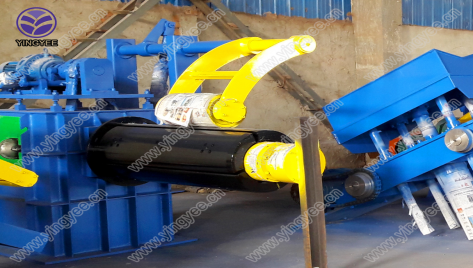
Understanding Gutter Downpipe Roll Forming Machines
In modern construction and roofing projects, the need for efficient water drainage systems is paramount. One of the key components of these systems is the gutter and downpipe. To manufacture these essential elements, the gutter downpipe roll forming machine plays a critical role in creating high-quality, durable components. This article aims to explore the importance of these machines, their functionality, and the advantages they offer in the construction industry.
What is a Gutter Downpipe Roll Forming Machine?
A gutter downpipe roll forming machine is a specialized piece of equipment used to produce gutter systems and downpipes from metal sheets. It operates by feeding a flat strip of material through a series of rollers, which progressively shape the metal into the desired profile. The result is a continuous length of pre-formed guttering or downpipe ready for installation.
These machines are primarily used in the production of different types of gutters and downpipes, including K-style and half-round profiles, which are commonly found in residential and commercial buildings. They can accommodate a variety of materials, with galvanized steel, aluminum, and PVC being the most commonly used.
Functionality of the Machine
The gutter downpipe roll forming process begins with the selection of raw material, which is typically available in coils. The machine is designed to handle various material thicknesses and widths, depending on the specific requirements of the project. As the material enters the machine, it moves through multiple stations in the roll forming line.
1. Feed System The feed system ensures a smooth entry of the material into the roll forming machine, maintaining a precise alignment which is crucial for achieving uniform profiles.
2. Roll Forming Stations The heart of the machine consists of several roll forming stations. Each station progressively bends the strip in a predetermined manner, gradually achieving the desired gutter or downpipe shape. The rollers are precisely machined to ensure accurate profiles that meet industry standards.
3. Cutting Once the gutter or downpipe reaches the desired length, the machine includes an automated cutting system that slices the product to size. This process ensures minimal material waste and consistent lengths, which simplifies the installation process.

4. Stacking and Discharge After cutting, the finished products are stacked neatly and discharged for packaging and delivery.
Advantages of Using Roll Forming Machines
The use of gutter downpipe roll forming machines presents various benefits to manufacturers and contractors alike
1. Efficiency These machines can produce continuous lengths of gutter and downpipe at a high speed, significantly reducing the time required for production compared to traditional methods.
2. Precision The automated nature of the roll forming process ensures high accuracy in dimensions and profiles, leading to a superior fit during installation.
3. Reduced Waste The system is designed to optimize material usage, resulting in minimal waste. This not only lowers production costs but also contributes to a more sustainable manufacturing process.
4. Customization Manufacturers can easily adjust the machine to create custom profiles, catering to unique architectural needs or client specifications without extensive retooling.
5. Durability Products produced through roll forming generally exhibit improved strength and longevity due to the cold-forming process, which aligns the material’s grain structure.
Conclusion
In conclusion, gutter downpipe roll forming machines are pivotal in ensuring efficient and effective production of water drainage systems in the construction industry. Their ability to produce high-quality, customized products at a rapid pace while minimizing waste makes them an essential tool for manufacturers. As the demand for durable and efficient building materials continues to rise, the role of these machines will undoubtedly become even more significant in the decades to come. Investing in advanced gutter downpipe roll forming machinery not only enhances operational efficiency but also positions manufacturers to cater to an ever-evolving market.